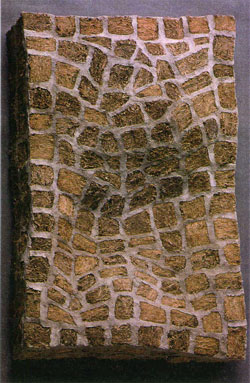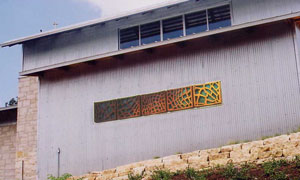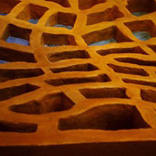The human hand is a curious thing. It’s fringeware design allows us to count up to five, an ability which came in handy when it was time to organize perception (five senses), space (five directions), the primal elements (earth, fire, water, air, space); as well as calculate the average number of days it takes to reach a representative at Southwestern Bell.
In cosmologies ranging from Vedic to Navajo, it is the quintessential number, ultimately showing up as God Herself in Luc Besson’s The Fifth Element.
Sculptor Virginia Fleck likes to make five-sided things out of other five-sided things. You may know her work from Juan Veramendi Park in San Marcos, the Austin Museum of Art‘s Groundswell show, or her solo exhibit at Women and Their Work. A tall, easygoing woman with a facetious glint in her eye, the thirty-six year old artist upholsters concrete and weaves dirt, softening and frumpifying the obdurate stuff beneath our feet. Flatbed‘s Mark Smith called her sod boxes “entropaic,” attributing their lack of rectitude to leaky thermodynamics, but Fleck will tell you that it is the pleasure principle that drives her hand. “These shapes are straight out of my childhood,” says the sculptor. “I grew up in Washington Heights, and our neighborhood was full of mortar and brick. Many of my friends lived in Brooklyn, so brownstones were also part of the picture. Lots of right angles.
“I found myself drawn to that fired-brick form, but chose a material that would relax and expand, slipping out of my control. Sod brick is held together by the root system of the grasses growing through it, and produces a building block that responds to humidity and temperature. It’s more of a membrane than a barrier. Like human skin.”
It wasn’t just the organic quality of Fleck’s work that caught EMS district director Jason Martin’s attention. “Our new station was to be situated on the hill overlooking Deep Eddy Pool,” he said. The 90-year old pool is on a swath of greenbelt which includes the former nature science center and Eilers Park, feeding into the Town Lake hike-and-bike trail. “We were looking for an artist familiar with the terrain around the station. In my first interview with Virginia I discovered that she and her family had spent many hours exploring the nearby trails and woods, getting to know the plants and animals in the neighborhood. And her proposal seemed to reflect that sensibility.”
The building, designed by architect Orit Nezer (of Austin’s Morales & Associates), was constructed from Hill Country materials, primarily rough-cut limestone and corrugated steel, with stained wood panels warming the colors near the roofline. Fleck studied the larger outlines of the architectural plan, looking for ways to accommodate and creatively resist the limits of its frame. For this project, she disintegrated her 1998 Rectangular Imprint, and reworked its patterns into a set of panels for the exterior wall facing the pool. Out of the pregnant cube, she created a flowing web negative in five sections, sockets just deep enough to hold a handful of light. “The relentless solar arc makes of every angular object a sundial.” The quotation from John Updike provoked the artist to experiment with a dual rhythm of colors — the exterior of the relief unfolded in a wide cadence, from glossy maroons to sennet to a shadowy marigold, swept along the five panels. The interior is a spectrum of blues, powdered aquamarines washed to the bottom of a shallow stream.
The building is sited on an east/west axis, so that the ‘solar arc” falls across the sculpture throughout the day. This addresses another of Fleck’s concerns: the variable quality of real (as opposed to “clock”) time. If every object is a sundial, each denotes time’s passage differently. Just as air, water and nutrients work a distinct path through our bodies, each day we pass through time (and time through us) with variable resistance.
Even the location of the work suggests this layering of time (or “times”): from one side it overlooks Deep Eddy Pool, a place for lolling if ever there was one. Yet the building itself, EMS Station #17, houses those indispensible makers-of-haste, emergency medical personnel. At their confluence, Fleck’s sculpture shows us that the measure of time is bound to the nature of place. A place composed of when we are, as well as where.
Images courtesy of the artist.
Alana Keres, Experimental Ontologist, lives in Austin, Texas.







